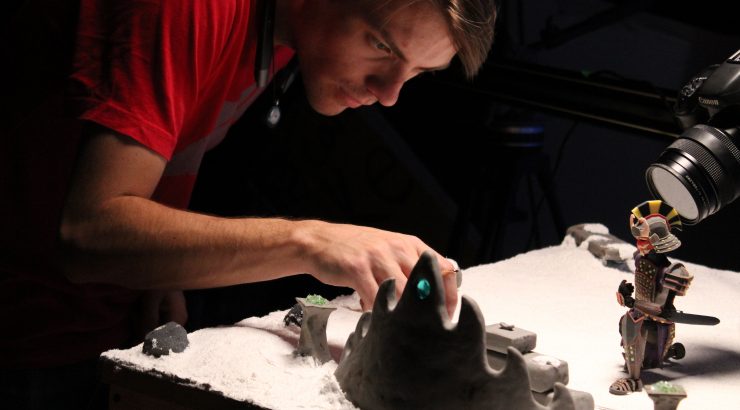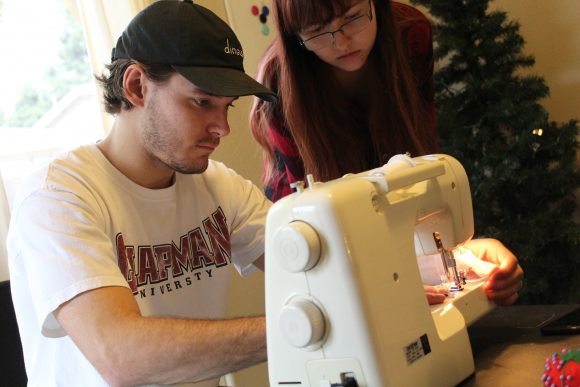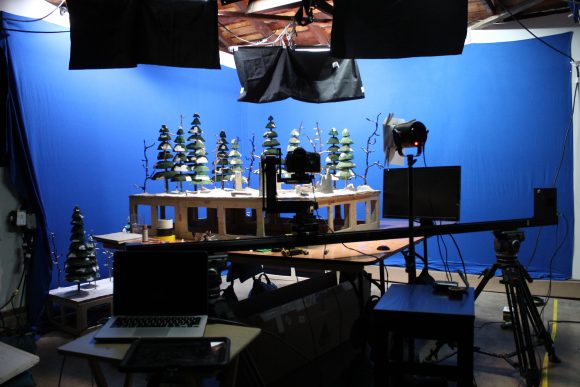
Stop Motion Marries Visual Effects and Animation to Tell a Warrior’s Story
June 18, 2018
It’s probably safe to say that patience is not a defining characteristic of most college students. But when Taylor Johnston (BFA/DA ’18) and Austin Piko (BFA/DA ’18) decided to make a stop-motion animated film for their senior thesis, they took the demand for patience to a whole new level.
Johnston and Piko are co-directing a story they wrote about a fatally wounded warrior who stumbles upon a ruined shrine and its fierce guardian spirit. The warrior, Meraki, decides to sacrifice his own life in order to save the spirit and bring peace to the shrine.
Shot at 24 frames per second, the four-minute film required more than 5,700 frames which, at approximately one to two hours per second of animation when the character moved (although faster when only the camera moved across a static scene and the character did not move), took somewhere in the neighborhood of 280 hours, or 35 eight-hour days to shoot. And, as Johnston adds, that did not include an entire first semester of pre-production during which “we easily spent over 100+ hours on building the set, modeling the character, making the costume and doing storyboards (and revisions).”
Along the way, Johnston and Piko faced a multitude of challenges, from designing every element of the film, including making all of the stages, the terrain, costumes and props from scratch, to figuring out how to composite special effects such as smoke particles, key out the blue screen, and roto-scope out rigs and other supports used for the warrior puppet and other structural elements.

Taylor Johnston ’18 works on costumes for the film’s main character.
“A big part of stop-motion is problem-solving on the fly,” says Piko. For example, they had to design costumes “with no sewing experience” that were sturdy enough to not to move on their own yet also be removable so the character’s mechanical joints could be tightened by hand. They also had to compensate for human error, as “one bump into the stage could shift the frame entirely,” Johnston adds.
The students used Nuke, After Effects, Maya and Dragonframe software packages to bring their vision to life and were thrilled by the support of a $5,000 grant and the use of a PC workstation from AMD Studios. They also worked with Purple Porcupine, a local 3D printing company, to print armor and 70 unique faces for the character. “I am specializing in the stop-motion aspects of the film and Austin is using his special effects wizardry to bring the spirit to life and bridge our two mediums,” says Johnston.
The story of Meraki was inspired by Johnston and Piko’s participation in last year’s summer travel course led by Animation and Visual Effects program director Bill Kroyer, which took the students to Japan to visit leading artists and animation studios. The Greek word “meraki,” Johnston says, refers to doing something with soul, creativity or love, when you “put something of yourself” into whatever you’re doing. “This film is our meraki, and the story is our character performing his meraki.”

Behind the scenes photo of the set of Meraki film.
Johnston and Piko are fully immersed in taking the film through post-production. What attracted them to such a demanding project? The desire to make something that would stand out from traditional 2D and 3D projects, love of the stop-motion films such as those featuring the characters Wallace and Gromit, and the belief that no matter how well 3D computer animation can replicate the
detail and feel of real-world materials, the textures of actual physical objects and the light they reflect are more true to life on screen.
The result? “This has been the coolest experience of my life,” says Johnston, “and I cannot wait to finish. We have a lot of post-production ahead of us, but we are eager and ready for the work ahead.” Or, to put it another way, it’s meraki at work.

